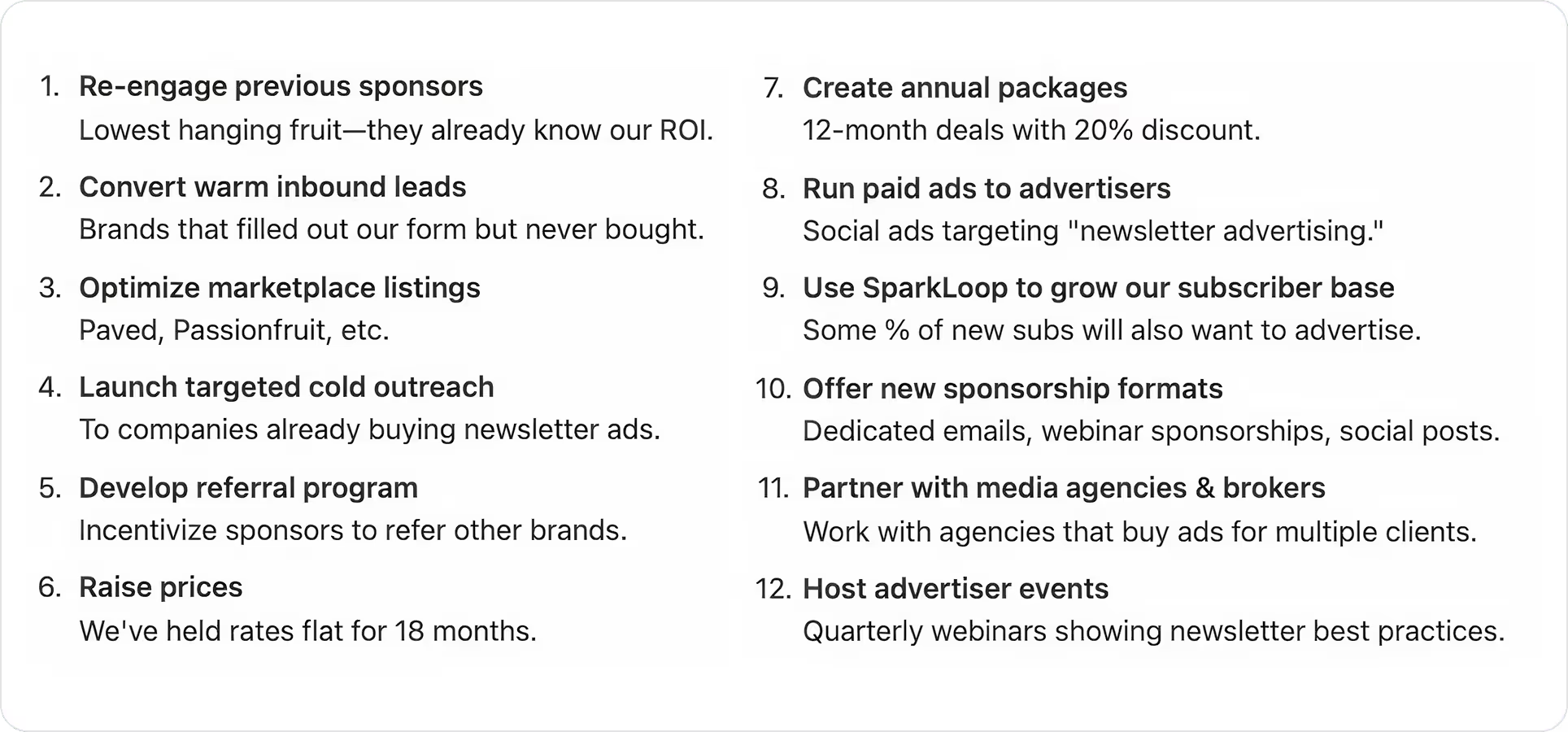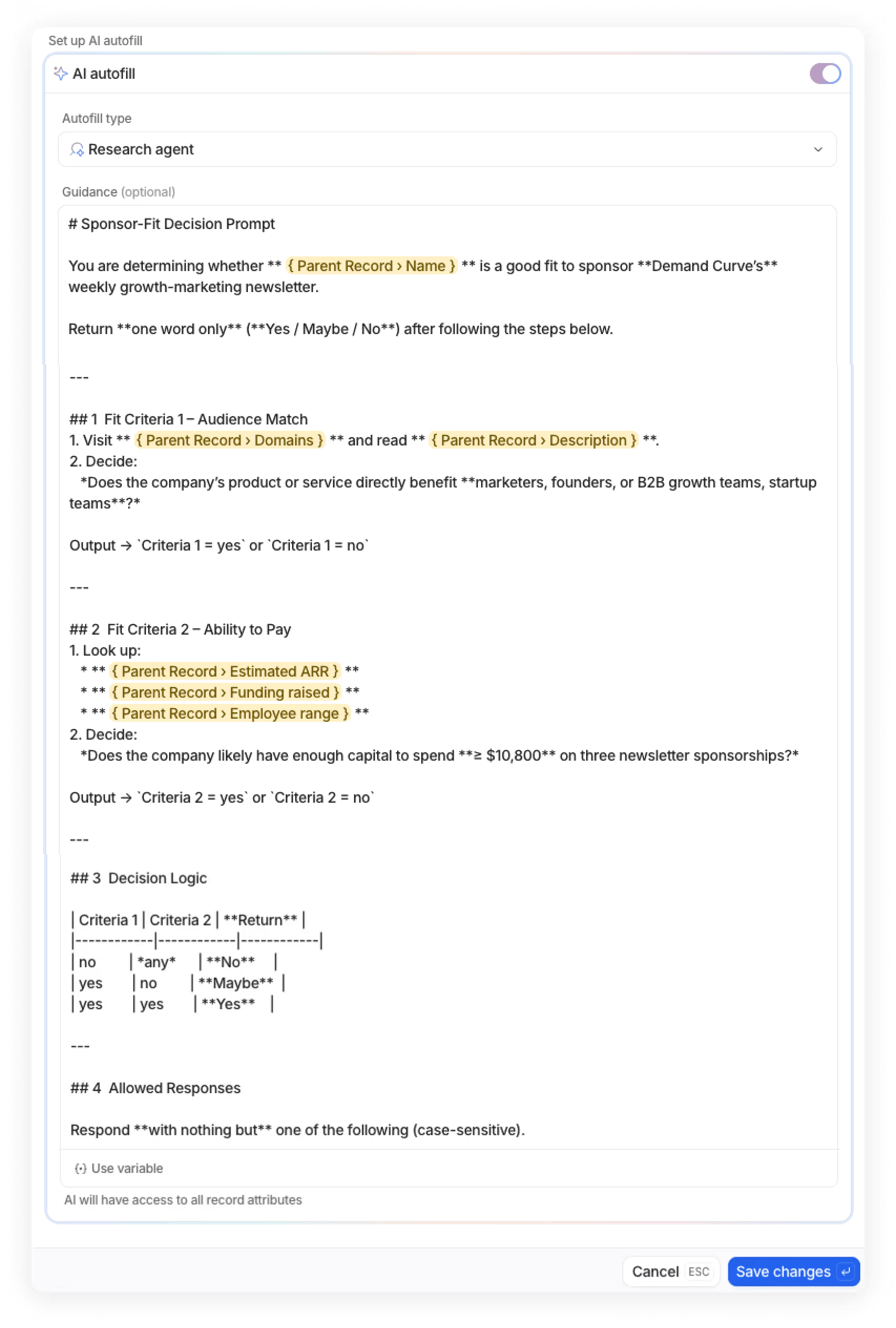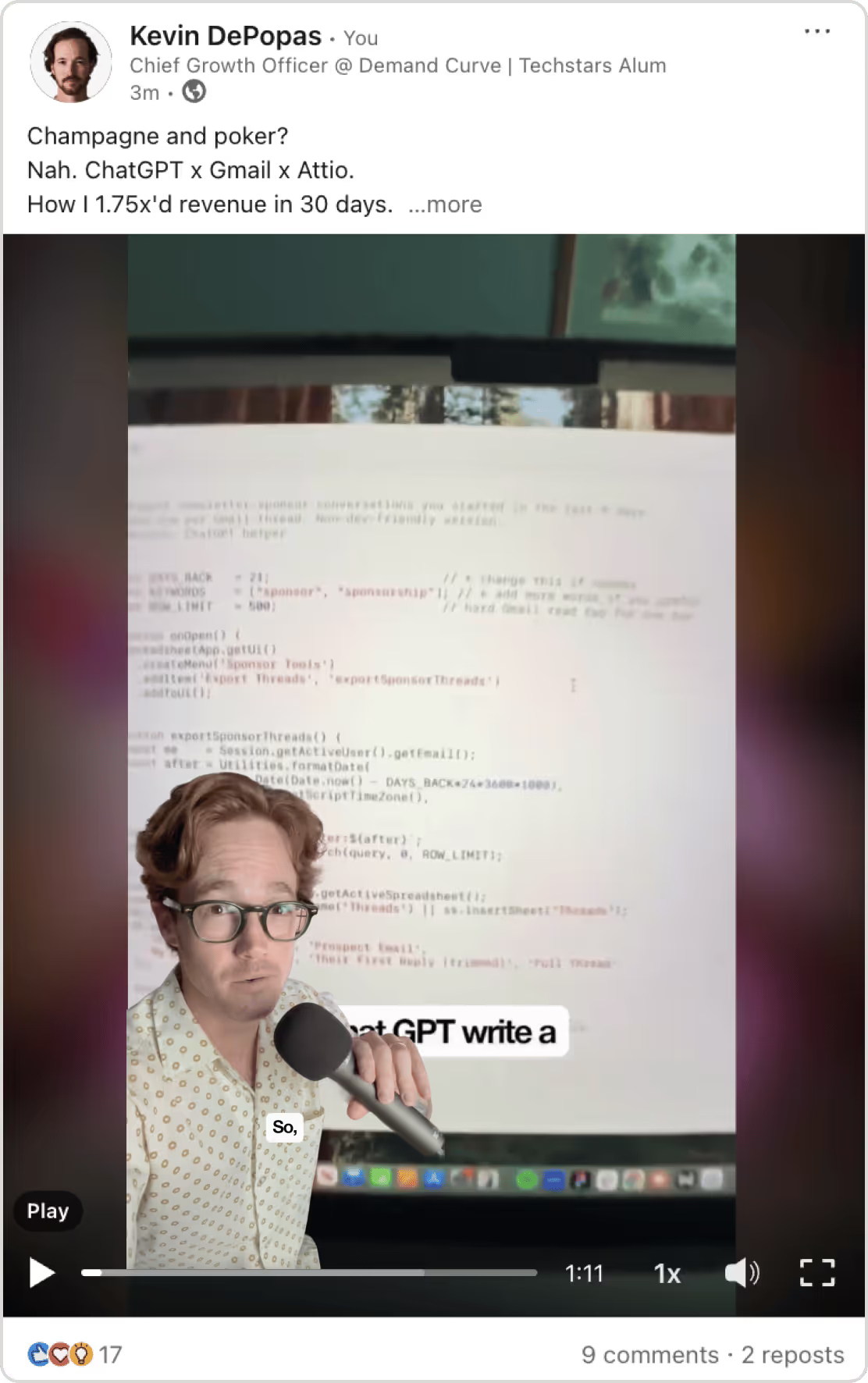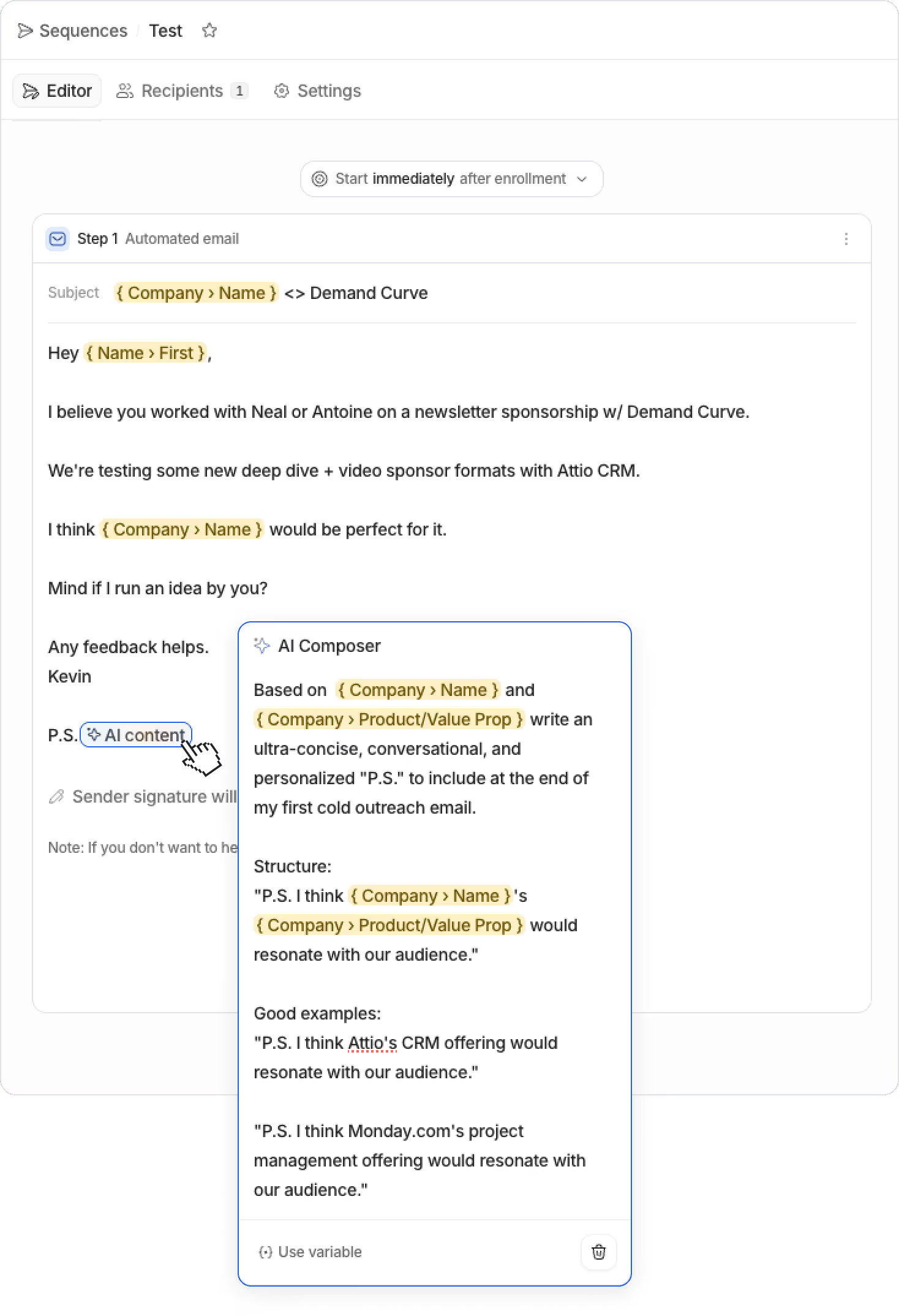Growth Newsletter #262
What’s the fastest way to double revenue?
This is the question our CEO (Justin Setzer) and I asked ourselves the first week of June, related to our newsletter sponsorship business.
Not because it was broken, but because it was running on autopilot, so we never bothered to optimize it.
In 14 days, we generated 24 active deals using a workflow that took 4 hours to build.
So far, we've increased July/August sponsor revenue by 1.75x vs. May/June, tracking towards 2x.
We didn't launch any new channels. Just better infrastructure and systems.
Here’s exactly how we did it.
- Kevin
This week's tactics
Doubling Our Sponsorship Revenue in 30 Days
Insight from Kevin DePopas - our Chief Growth Officer
Over the years, our newsletter sponsorship business has essentially run itself. Inbound inquiries flow through our website, occasional leads come from marketplace aggregators like Passionfroot and Paved, and revenue remains stable without much intervention.
With our heads down relaunching Growth Program 2.0, sponsorship revenue hadn't gotten much love from a growth standpoint.
During the second week of June, Justin (our CEO) and I mapped out Q3 priorities. We decided it was time for a quick 80/20 sprint to improve newsletter revenue and operations.
The goal: Double sponsorship revenue in 30 days (doing as little work as possible).
The challenge: We had contacts scattered across email threads, a basic Notion database acting as our "CRM," Sponsy (where we host our newsletter storefront), and no systematic approach to nurturing leads.
Here’s how we began to tackle the opportunity.
Understanding Our Options, Shrinking the Problem
I needed to understand what we were working with, so I mapped out the top ways to grow newsletter revenue:

After some thinking, we agreed that our fastest path to near-term revenue (without incurring too much operational overhead) was reconnecting with people who already know us…
- Previous Sponsors
- Warm Inquiries
The two categories comprised hundreds of potential deals just waiting for follow-up. Now that we had our priorities, we moved on to the next challenge, getting organized.
Getting Organized, Finding the Right Infrastructure
Before reaching out to these two buckets of prospects, I needed somewhere to house the data and manage the process.
After researching options, I landed on Attio. They'd sponsored our newsletter months back, and their AI-native CRM positioning and Notion-esque UI/UX intrigued me.
I reached out to see if they'd be comfortable with me documenting my experience using their tool.
They agreed and are sponsoring this issue, but everything you're about to read is my genuine experience using their tool. Attio has since become our main CRM.
The Implementation, Multiple Tools, One Workflow
Here's the workflow I built. It involves several tools working together, with Attio as the central hub.
Step 1: Data Extraction & Import
First, I pulled two lists:
- Previous sponsors from Sponsy (our sponsorship management tool).
- Inbound inquiries from Tally forms that pipe into Notion.
I uploaded these as CSVs into Attio, creating a unified deals “list”. While the CSVs only contained basic company info fields (company name, domain, and main contact email), Attio automatically enriched all the other data I needed (company descriptions, revenue estimates, employee counts, LinkedIn profile URLs, previous email conversations, etc.).
Step 2: Intelligent Filtering with AI Fields
Next, I didn't want to waste time nurturing prospects if they weren't a good fit to sponsor our newsletter. I decided all previous sponsors were worth reaching out to, but I needed to filter the larger list of inbound inquiries that never converted.
Attio lets you create “AI Attribute” fields that analyze structured and unstructured data using LLMs. I figured I could use a Research Agent attribute field to help me analyze and categorize inbound prospects based on fit.
So I created a "Sponsor Fit" field that evaluates each company based on two criteria:
- Whether they target startups/marketers
- Whether they have budget to support sponsorships
This cut my outreach list by 60%, focusing only on high-probability opportunities.

Note for builders: I was considering using a tool like Clay for filtering and data enrichment, but Attio handles similar enrichments internally without buying another tool or learning a new system. If Attio doesn't have an enrichment capability you need, you can fire workflows that integrate with Clay, n8n, or other tools. Simple enough for lightweight systems, but can scale if needed.
Step 3: Research for Personalization
Now that I had organized lists of previous sponsors and good-fit potential sponsors, it was time to plan the campaigns.
Data shows personalized emails can 2X+ response rates, so I wanted to tastefully incorporate personalization that proved we understand each company's product and how it relates to the Demand Curve audience.
To do this, I built another AI Research Agent Attribute field in Attio that:
- Visits each company's website
- Extracts their main product offering
- Summarizes key value props
- Formats it for email personalization
We’ll use this field later in our personalized email outreach, stick with me!

Step 4: Building Smart Campaigns
Time to put it all together. I built two campaigns in Attio:
- Campaign A (Previous Sponsors): Companies that have already sponsored our newsletter one or multiple times.
- Campaign B (Warm Inquiries): People who filled out our inbound form but didn't move forward AND met our “sponsor fit” threshold.

Step 5: Creating the Email Copy
Rather than crafting campaign copy from scratch, I wanted our emails to reflect how we actually talk about Demand Curve sponsorships.
I used ChatGPT o3 to build a scraper (via Google Apps Script) that pulled all my sales-related email conversations from the past two weeks into a Google Sheet. This captured how I handle objections, explain service offerings, answer questions, all the nuances of real conversations.
Vibe Coding Shoutout: I’m not a developer, so I had to vibe code this whole scraper. It took about 20 minutes.

I then exported the CSV of my sponsor sales conversations and fed it into a Claude 4.0 Opus Project, asking it to create simple 3-4 touch campaigns for each audience.
Pro tip: To improve your cold email quality, create a Claude Project and load it with training data from cold email experts. I loaded all of Lavender AI's cold emailing blog content into my project before feeding it my sales conversations.
Step 6: Personalizing with AI Content
Research from Lavender AI shows that including a personalized "P.S." at the end of emails can increase reply rates by 35%.
So I used Attio's AI Variable functionality within my email sequence to reference the “Product/Value Prop” field I created earlier, and use it to create personalized P.S. lines for each prospect:
"P.S. I think {Company Name}’s {AI Field: Product/Value Prop} would resonate with our audience."

Notice how I'm able to reference the AI Research Agent field I created earlier (Product/Value Prop) as a prompt input within Attio's AI email variable.
Results So Far
I ran the campaigns for 14 days and have continued any active sales conversations since. Here are the preliminary results (as of 7/15):
- 32% campaign reply rate (industry average is 8-10%)
- 24 active deals initiated from initial campaigns
- 4 package deals closed so far
- 9 deals active (still in conversation)
Want to join the mix for Q3/Q4 sponsorships? Email me. 😉
What's working well:
- AI enrichment saved hours of manual research.
- The AI variable within email templates (and it's ability to reference other AI fields as prompt inputs) is a powerful feature I haven’t seen in many other email tools.
- Everything lives in one place, Attio acts as my hub, consolidates sheets and Notion into a single source of truth.
- Attio’s Call Intelligence meeting assistant joins my calls and captures notes/follow-up items (I didn’t even realize this was a feature when I signed up, but I’m liking it).
- As an avid Notion user (and a sucker for good design), I appreciate the thoughtfulness of Attio's UI/UX.
Looking ahead: I'm excited to see how Attio continues developing agentic capabilities. Similar to how Attio removes the need for Clay for lightweight enrichment, with further development, it could eliminate the need for n8n for AI automation use cases.
I'd also love if Attio's AI fields allowed connecting custom LLMs for more flexibility in what models run on the backend, getting closer to Clay's customization options.
The Consolidation Potential
As I built the workflow above, it was hard to ignore that Attio could potentially replace multiple tools in our stack.
- CRM: If you're using Notion as a makeshift CRM (like we were), Attio can obviously replace that.
- Data Enrichment: If you're contemplating Clay for enrichment, I’d test out Attio first to save yourself another subscription.
- Meeting Recordings: Paying for meeting recording tools? Attio can likely replace these.
- Email Sequences: Attio's built-in email automation can potentially save you yet another SaaS subscription. (Attio also has a pretty seamless integration with Mixmax that I’m playing with).
We haven't consolidated everything yet, but the potential is there. And for smaller teams, this could mean significant simplification and cost savings.
If You're Thinking About Modernizing Your Sales Stack
Attio genuinely surprised me. The AI features aren't an afterthought, they're front and center throughout the application. The interface is clean enough that our team actually uses it. And the potential for tool consolidation is real.
If you're like I was (cobbling together spreadsheets, losing track of conversations, missing follow-ups) it's worth exploring.
Try Attio free for 14 days →
No credit card required.
Community Spotlight
News and Links
Something fun
Something fun
Cheeky Stella Artois can design that adheres to Wimbledon’s strict dress code of "Suitable tennis attire that is almost entirely white."





















